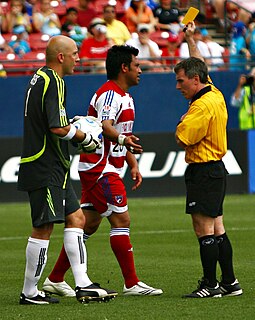 W
WThe term "behind closed doors" is used in several sports, primarily association football, to describe matches played where spectators are not allowed in the stadium to watch. The reasons for this may include punishment for a team found guilty of a certain act in the past, stadium safety issues, public health concerns, or to prevent potentially dangerous clashes between rival supporters. In football it is predicated by articles 7, 12 and 24 of FIFA's disciplinary code.
 W
WA captain of a Gaelic games team, sometimes known as a skipper, is a player who, during the course of a match as well as before and after it, has several additional roles and responsibilities over and above those of his teammates.
 W
WThe county colours of an Irish county are the colours of the kit worn by that county's representative team in the inter-county competitions of the Gaelic Athletic Association (GAA), the most important of which are the All-Ireland Senior Football Championship and the All-Ireland Senior Hurling Championship. Fans attending matches often wear replica jerseys, and wave flags and banners in the county colours. In the build-up to a major match, flags and bunting are flown or hung from cars, buildings, telegraph poles, and other fixtures across the county, especially in those regions where GAA support is strong.
 W
WDual county is a term used in Gaelic games to describe a county that competes at a similar level in both hurling and Gaelic football. For example, Dublin play in Division 1 in both the NHL and NFL, while Laois compete in the second tier of the football competition and the first tier of the hurling competition.
 W
WThe following article gives a list of Gaelic games governing bodies, county boards and associations around the world. The principal governing body is the Gaelic Athletic Association (GAA).
 W
WIn sport, a goal may refer to either an instance of scoring, or to the physical structure or area where an attacking team must send the ball or puck in order to score points. The structure of a goal varies from sport to sport, and one is placed at or near each end of the playing field for each team to defend. For many sports, each goal structure usually consists of two vertical posts, called goal posts, supporting a horizontal crossbar. A goal line marked on the playing surface between the goal posts demarcates the goal area. Thus, the objective is to send the ball or puck between the goal posts, under or over the crossbar, and across the goal line. Other sports may have other types of structures or areas where the ball or puck must pass through, such as the basketball hoop.
 W
WIn sports, a goal celebration is the practice of celebrating the scoring of a goal. The celebration is normally performed by the goalscorer, and may involve their teammates, the manager or coaching staff or the supporters of the team. Whilst referring to the celebration of a goal in general, the term can also be applied to specific actions, such as a player removing their shirt or performing a somersault. Celebrations are generally more substantial in lower-scoring sports, such as association football and ice hockey, where a score has greater significance.
 W
WThe following are the positions in the Gaelic sports of Gaelic football, hurling and camogie.
 W
WHawk-Eye is a computer vision system used in numerous sports such as cricket, tennis, Gaelic football, badminton, hurling, rugby union, association football and volleyball, to visually track the trajectory of the ball and display a profile of its statistically most likely path as a moving image. The onscreen representation of the trajectory results is called Shot Spot.
 W
WIn Gaelic games, a manager or bainisteoir is involved in the direction and instruction of the on-field operations of a team. The role entails the application of sport tactics and strategies during the game itself, and usually entails substitution of players and other such actions as needed. At games, the manager may sometimes wear a bib with the word "manager" or "bainisteoir" adorning it. Many managers were former players themselves, and are assisted in coaching the team by a group of selectors.
 W
WPenalty cards are used in many sports as a means of warning, reprimanding or penalising a player, coach or team official. Penalty cards are most commonly used by referees or umpires to indicate that a player has committed an offence. The official will hold the card above their head while looking or pointing towards the player that has committed the offence. This action makes the decision clear to all players, as well as spectators and other officials in a manner that is language-neutral. The colour or shape of the card used by the official indicates the type or seriousness of the offence and the level of punishment that is to be applied. Yellow and red cards are the most common, typically indicating, respectively, cautions and dismissals.
 W
WThis page discusses scoring in the Gaelic games of hurling, Gaelic football, camogie, ladies' Gaelic football, international rules football and shinty-hurling.